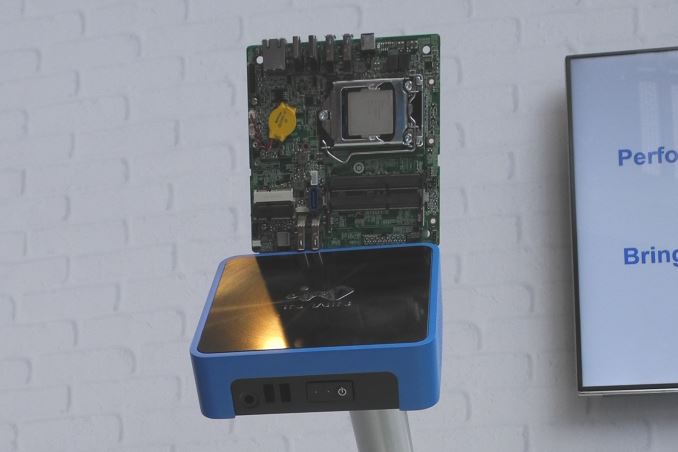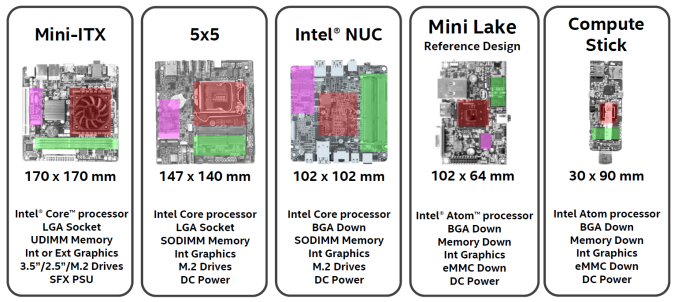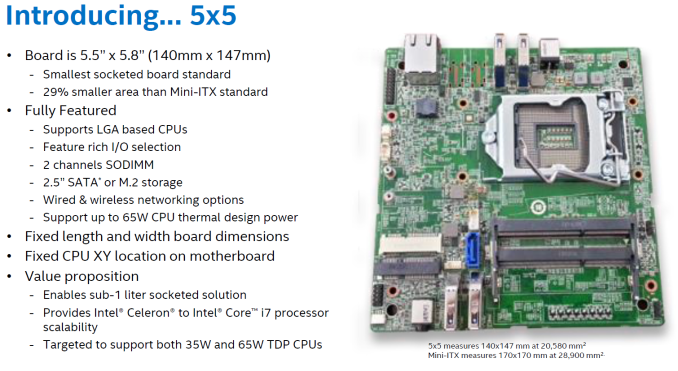Intel Launches New Socketed 5x5 mini-PC Motherboards
by Ganesh T S on August 24, 2015 4:35 AM EST- Posted in
- Trade Shows
- Systems
- Intel
- Motherboards
- Mini-PC
- IDF 2015
- 5x5

Over the last couple of years, the ultra-compact form factor (UCFF) has emerged as one of the bright spots in the troubled PC market. Kickstarted by Intel's NUC (Next Unit of Computing) designs, it has been successfully cloned by other vendors such as GIGABYTE (BRIX), Zotac (C-series nano) and ASRock (Beebox). With platform performance increasing every generation, and performance requirements getting tempered by the rise of the not-so-powerful smartphones and tablets, Intel could pack a heavy punch with their 102x102mm NUC motherboards.
Atom-based units (using Bay Trail) could provide very good performance for most users. Intel tried to shrink the PC even further by releasing a Compute Stick based on the Bay Trail Atom Z series SoCs earlier this year. ECS, with their LIVA designs, has adopted the Mini Lake reference design for their UCFF PCs. All of these UCFF PCs come with BGA CPUs / SoCs. The configurability aspect is minimal from an end-user's perspective. Looking at the mini-ITX form factor immediately leads us to a hole in the mini-PC lineup between it and the NUC.
At IDF last week, Intel quietly launched the new 5x5 motherboard form factor. Coming in at 147x140mm, it is closer to the NUC in the fact that it can operate directly off DC power and takes SODIMM memory. Approaching from the mini-ITX side gives us the LGA socket for a Core processor. Unfortunately, at this size, we have to make do without the full length PCIe slot.
Intel suggests that solutions using the 5x5 boards could come in with a 39mm height for a volume of 0.89L (when using M.2 drives and a heat sink suitable for 35W TDP CPUs). 65W TDP CPUs and 2.5" drive support would obviously increase the height requirements.
Many usage areas which required custom-sized embedded boards (such as digital signage / point of sale terminals / kiosks etc.) have now opened up for the PC, thanks to the NUC and other similar form factors that were introduced over the last year or so. The new 5x5 form factor ensures that a mini-PC is available for every size and performance requirement. As of now, it looks like In-Win has a chassis design ready for the new form factor. We are awaiting more information on the board(s) and availability details.












44 Comments
View All Comments
OrphanageExplosion - Monday, August 24, 2015 - link
I like the idea of a tiny Broadwell system, but you're going to need to decent cooling. I had the Iris Pro Gigabyte Brix on loan and it throttled badly and was extremely noisy. Was tempted to buy one before until I actually tried it.James5mith - Monday, August 24, 2015 - link
Still waiting for the day when Intel puts dual-NICs on a NUC so I can have a nice, powerful, super compact home router. I don't want dongles, etc. I'd gladly give up extra graphical I/O ports to get dual GbE NICs onboard.WorldWithoutMadness - Monday, August 24, 2015 - link
I'm curious about what rules/restrictions you are going to put that needs NUC computational power (assuming >=i3)? or is it including other features like NAS?alaricljs - Monday, August 24, 2015 - link
web proxy - with kids in the house I need to start dealing with this. *sigh*WorldWithoutMadness - Monday, August 24, 2015 - link
Not might as powerful like i3ish but if you're looking something dual intel nic with nuc form factor, this might help http://www.jetwaycomputer.com/JBC311U93.htmlwintermute000 - Sunday, August 30, 2015 - link
your best bet is still to use a traditional ITX build but then go all the way and do an ESXi or Hyper-V all-in-one i.e. use it to run server functions as well as having a virtual router/FW appliance. I know quite a few people doing this with pfsense etc. and it works well if you know what you're doing. If you really want to walk on the wild side you can virtualise your storage appliance as wellcbf123 - Thursday, September 3, 2015 - link
Just saw this, so hopefully you get notified of a response. I just picked up a Zotac ZBOX-CI321NANO. (http://www.zotac.com/ca/products/mini-pcs/zbox-c-s...Weakish CPU, but lots of I/O. Dual gigabit, dual-band wifi, Bluetooth, HDMI and DisplayPort, card reader, four USB 3.0 ports and a USB 2.0 port, etc.
And it's relatively inexpensive.
Metaluna - Tuesday, December 8, 2015 - link
I gave up waiting and bit the bullet with an Atom-based headless router system from Netgate. These are probably $100-200 more expensive than a carefully selected set of consumer components but they come with everything including RAM and an eMMC flash drive on the motherboard, etc. The Rangeley Atoms should be plenty fast for things like Snort, though you'd probably need to add an extra m.2 or mSATA drive for logging.DanNeely - Monday, August 24, 2015 - link
With the loss of the PCIe slot I think this really needs to be looked at as a scaled up NUC not a scaled down mITX system. From that standpoint it actually looks like a reasonable option (assuming sane pricing anyway). For non-gaming purposes Intel's reference boards look like they've got all the bases covered while the socketed CPU options allows for significantly more CPU performance at similar cost/power levels.If it's intended as an open standard, using a desktop chipset should give 3rd parties enough sata ports to make DIY NAS suitable boards. A smaller board would be nice for them; since currently it's the dimensions of an mITX board that limits the physical size of 2/4 bay cases. For the loads those systems run at, a $100W DC brick is more reasonably sized option than a 250+W ATX/SFX power supply.
My last thought is to wonder if Intel was aiming for a smaller board size. They're calling it 5x5 but ended up closer to 6x6.
V900 - Monday, August 24, 2015 - link
Thank god! If it wasn't for Intel, we'd all be facing a dark, depressing future where miniITX is too big, NUC is too small and minilake isn't square enough!Thank you Intel, for striking a crippling blow against the tyranny of sub 17cm form factors!
No longer will customers be forced to choose between boards that are either way too small, or small, but still a teensy cm too big... Phew!
I know Intel has been getting some criticism lately, with Skylake being a disappointment performance wise, and Canonlake postponed for two years, but let's give them a little slack. Clearly the 5x5 board shows that Intel are not afraid of taking bold risks, are in tune with their customers and have their finger right on the pulse of the marketplace...